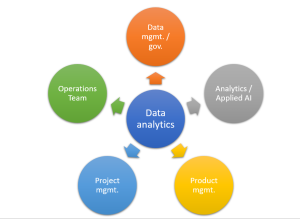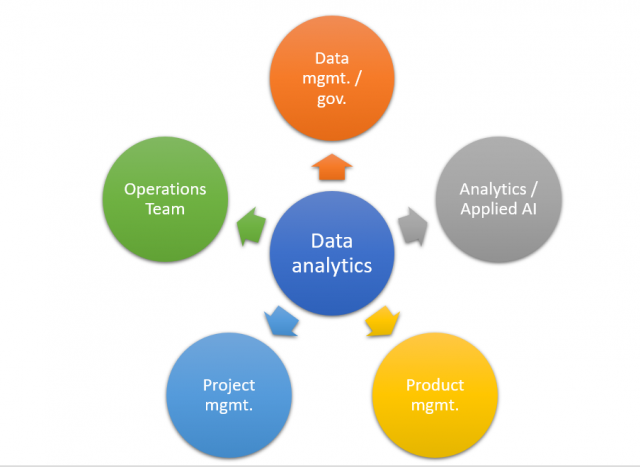
Most businesses these days are collecting and analyzing data to help them make better decisions. However, in order to do this effectively, they need to build a data analytics organization. This involves hiring the right people with the right skills, setting up the right infrastructure and creating the right processes.
In this article, we’ll take a closer look at what it takes to set up a successful data analytics organization. We’ll start by discussing the importance of having the right team in place. Then we’ll look at some of the key infrastructure components that need to be put in place. Finally, we’ll discuss some of the key process considerations that need to be taken into account.
Building a data analytics organization
A data analytics organization is a critical component of any business that wants to make decisions based on data. The most important thing to keep in mind when setting up a data analytics organization is that it’s not just about hiring the right people. You also need to make sure you have the right infrastructure and processes in place.
The first step is to hire the right team. This includes people with expertise in data analysis, as well as people with the necessary technical skills. You also need to make sure you have people with the right business skills, such as project management and communication skills. The following represents expertise of key staff members:
- Data visualization
- Analytics engineering
- Data scientist
- Data engineering
- Data management
- Data governance
- Business analyst
Once you have the right team in place, you need to make sure you have the right infrastructure in place. This includes things like a data warehouse, a data lake, and a BI platform. You also need to make sure you have the necessary tools and technologies, such as SQL, Python, R, and Hadoop.
Finally, you need to make sure you have the right processes in place. This includes things like data collection, data cleansing, data transformation, and data analysis. It’s also important to have a process for sharing insights with decision makers across the organization.
The key team members you need
The following represents key teams and related expertise / experience in different domains including technology, product and project management and operations, you need in your data analytics organization:
- Data management / governance:
- Data analyst: The roles & responsibilities of data analysts is to analyze data and extract insights from the data.
- Data engineer: Data engineers design, build, and maintain the data infrastructure. Some of the tools that data engineers work with are Big data based tools such as Hadoop, Spark, and Hive. They need to have good expertise and experience with cloud tools related to Amazon, Google cloud, Azure, etc. Examples of such tools include AWS S3, AWS EMR, Google Dataproc, and Azure HDInsight, etc.
- Data governance experts: Data governance professionals ensure that data quality standards are met. Some of the tools that data governance experts use are Data Quality Management (DQM) platforms and Data profiling tools.
- Data management team: Data management team members are responsible for managing and controlling the data. Some of the tools that Data management team uses are data quality management (DQM) platforms, data classification tools, and Master Data Management (MDM) platforms.
- Analytics team:
- Data scientist: Data scientists analyze data and extract insights from the data. They also build predictive models and algorithms. Some of the tools that data scientists work with are R, Python, and machine learning platforms such as Amazon Sagemaker, etc.
- Analytics engineers: Analytics engineers design and build systems for deploying advanced analytics into production.
- Data visualization: Data visualization experts create visual representations of data to help people understand the data. Some of the tools that data visualization experts use are Tableau, Qlikview, and Power BI.
- Product management
- Business analyst: Business analysts understand the business needs and requirements. They also design and build the data analytics solution.
- Project management
- Project / Portfolio managers: Project managers are responsible for managing data analytics projects. They need to have good project management skills and knowledge. They work with tools such as Jira, Asana, and Trello.
- Operations Team
- DataOps / MLOps / AnalyticsOps Team: MLOps team members are responsible for deploying and managing machine learning models into production. They need to have good knowledge of DevOps tools and processes. They work with tools such as Jenkins, Azure DevOps, and Github. DataOps team members are responsible for managing and operating data infrastructure. They need to have good knowledge of data management tools and processes. They work with tools such as Cloudera Manager, Databricks, and Sqoop. AnalyticsOps team members are responsible for managing and operating data analytics infrastructure including data visualization platforms etc.
The key infrastructure components you need
There are a few key infrastructure components that any business needs in order to set up a data analytics organization. The first is a Data Warehouse. A data warehouse is a system that stores data in a way that allows for easy analysis. It’s important to have a data warehouse that can handle the volume and variety of data that you’re collecting. Examples of some of the popular data warehouse platforms are Amazon Redshift, Google BigQuery, and Azure Synapse Analytics.
The second key component is a Data Lake. A data lake is a system that stores data in its original format. This allows businesses to store all of their data in one place, which makes it easier to analyze. Examples of some popular data lakes are Amazon S3, Google Cloud Storage, and Azure Blob Storage.
The third key component is a BI platform. A BI platform allows businesses to analyze their data and get insights from it. It’s important to choose a BI platform that has the features and capabilities you need. Some of the popular BI platforms are Tableau, Qlikview, and Power BI. Cloud based BI platforms include Google Data Studio and Amazon QuickSight. Data visualization experts and data analysts will primarily be using the BI platform to extract insights from data.
The fourth key component is a Big Data platforms for data analytics. Big data platforms are designed to handle large volumes of data. They’re also able to process data in real-time, which is important for data analytics. Some of the popular big data platforms are Hadoop, Spark, and Hive. Cloud based big data platforms include Amazon EMR and Google Dataproc. Data engineers will be responsible for setting up and maintaining the big data platform.
The fifth key component is a Machine learning platforms. Machine learning is a type of artificial intelligence that allows businesses to get insights from their data without having to write code. Some of the popular machine learning platforms are Amazon Sagemaker, Google Cloud ML Engine, and Azure ML Studio.
The sixth key component is a data governance platform. A data governance platform helps businesses to manage their data. It’s important to choose a data governance platform that has the features and capabilities you need. Some of the popular data governance platforms are Data Quality Management (DQM) platforms and Data profiling tools.
The seventh key component is a project management tools. A project management tool helps businesses to manage data analytics projects. It’s important to choose a project management tool that has the features and capabilities you need. Some of the popular project management tools are Jira, Asana, and Trello.
The key process considerations you need to take into account
When building a data analytics organization, you need to make sure you have the right processes in place. This includes development processes, hiring processes and deployment processes.
- Development processes: In order to ensure that your data analytics organization is effective, you need to have a well-defined development process in place. This process should include steps for requirements gathering, design, testing and deployment. It’s important to make sure that all of your developers are following the same process so that everyone is working towards the same goal.
- Deployment Processes: Once your data analytics organization is up and running, you need to make sure you have a process in place for deploying your applications and data safely and securely. You should work with your IT department to create a plan for deploying your applications and data securely across your network. You should also make sure that you have procedures in place for backing up your data and restoring it if necessary.
- Hiring Processes: Hiring the right people is essential for a successful data analytics organization. You need to make sure you have the right mix of skillsets and experience in order to be able to collect and analyze data effectively. When hiring for a data analytics position, you should look for candidates with strong analytical skills, programming skills and business knowledge. You should also make sure that you have a rigorous interview process in place so that you can assess candidates accurately.
Data analytics organizations operating models
There are three main types of data analytics organizations: centralized, decentralized and hybrid.
- Centralized data analytics organizations: A centralized data analytics organization is one where all the data is collected and analyzed by a single team or department. This type of organization can be effective if you have a large amount of data to analyze. However, it can be difficult to manage and coordinate all the activities of a centralized organization.
- Decentralized data analytics organizations: A decentralized data analytics organization is one where different teams or departments collect and analyze their own data. This type of organization can be effective if you have a lot of data spread out across different departments. However, it can be difficult to consolidate all the data into a single repository for analysis.
- Hybrid data analytics organizations: A hybrid data analytics organization is one where some data is collected and analyzed by a centralized team or department, while other data is collected and analyzed by decentralized teams or departments. This type of organization can be effective if you want to benefit from the advantages of both centralized and decentralized organizations.
Conclusion
Building a data analytics organization can be a daunting task. However, by taking the time to plan and organize your efforts, you can create a successful data analytics operation that helps you make better decisions. The key team members for a data analytics organization include developers, analysts and business experts. The key infrastructure components include a Data Management platform, SQL tools, programming languages and big data platforms. The key process considerations include development processes, deployment processes, hiring processes and data management procedures. There are three main types of data analytics organizations: centralized, decentralized and hybrid. Each type has its own advantages and disadvantages. By understanding the different types of data analytics organizations and choosing the right one for your needs, you can create a successful data analytics operation.
- Coefficient of Variation in Regression Modelling: Example - November 9, 2025
- Chunking Strategies for RAG with Examples - November 2, 2025
- RAG Pipeline: 6 Steps for Creating Naive RAG App - November 1, 2025

I found it very helpful. However the differences are not too understandable for me